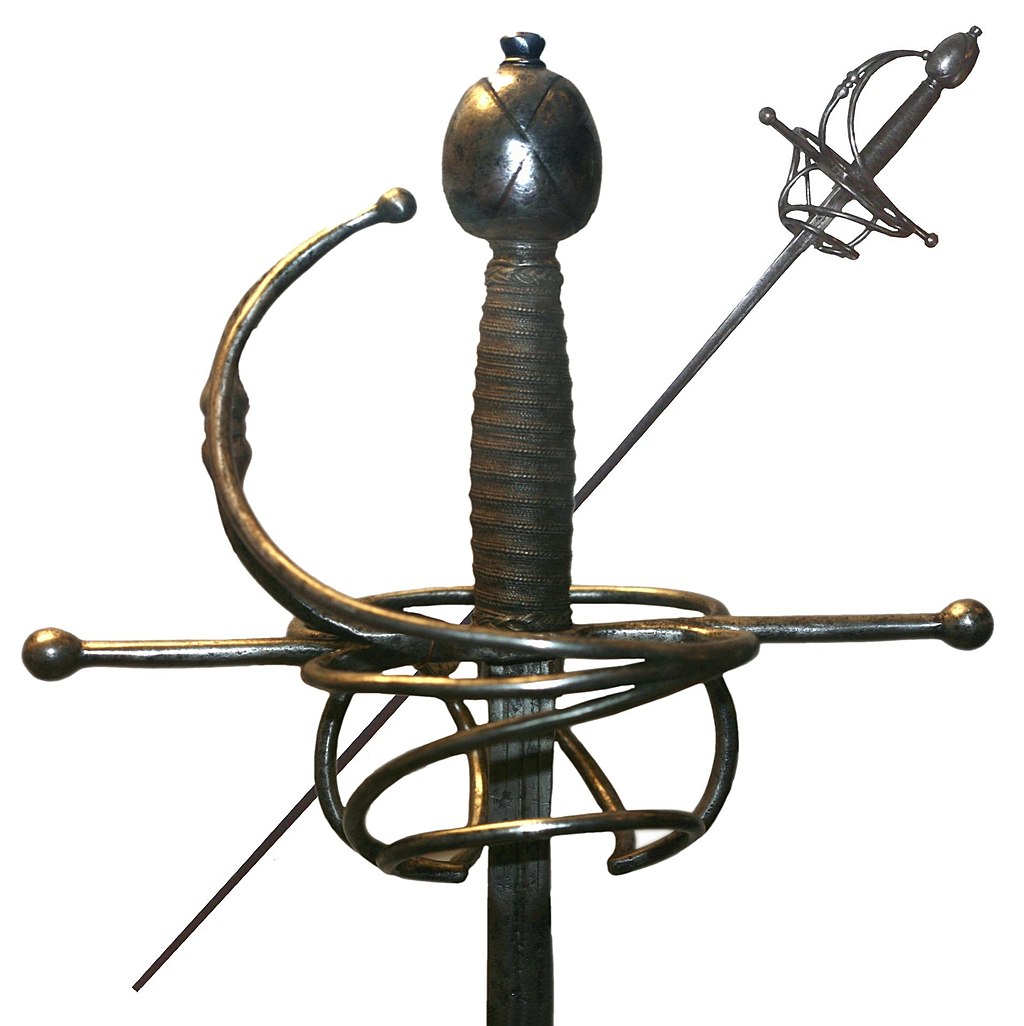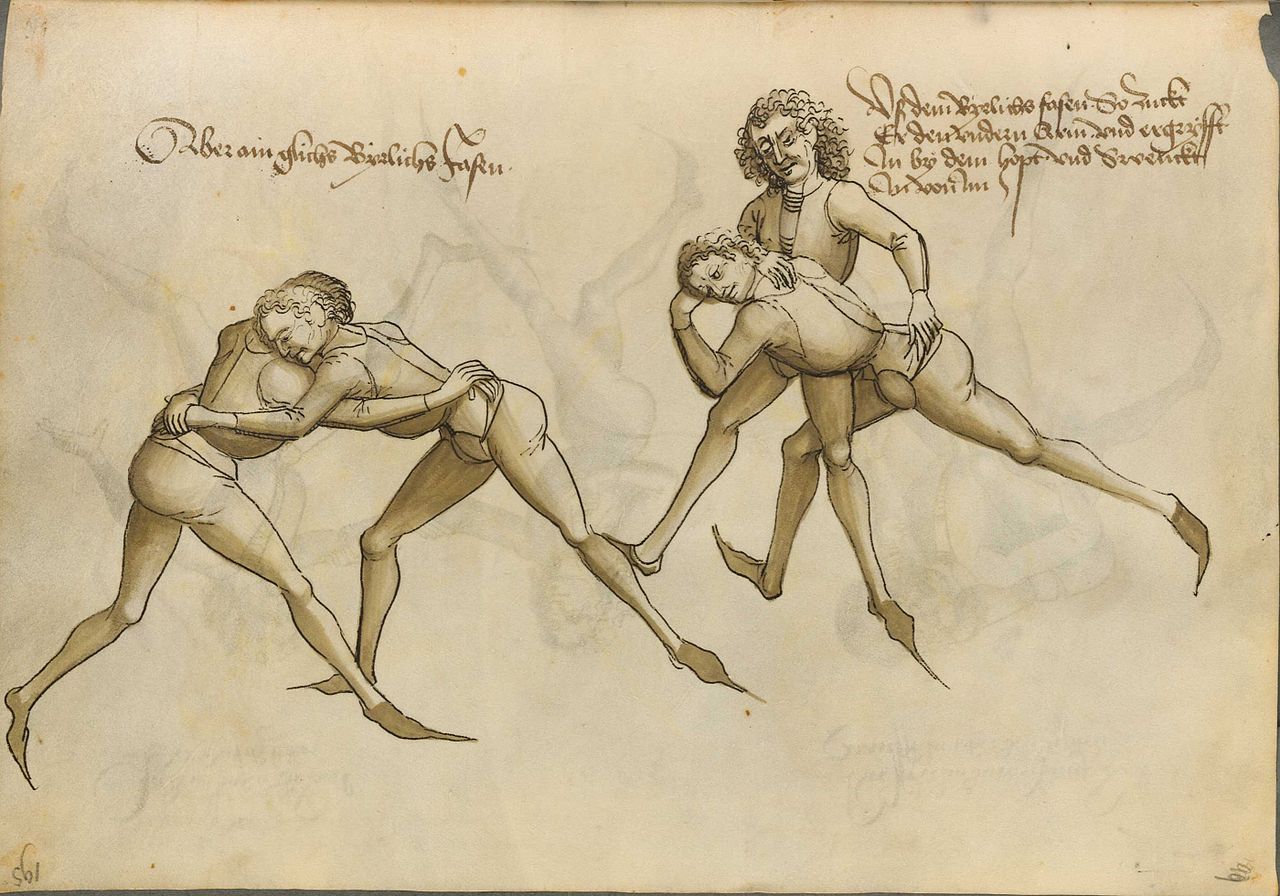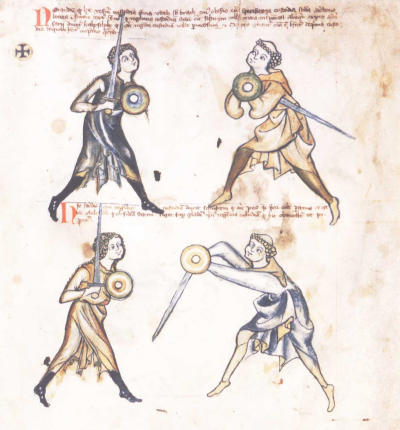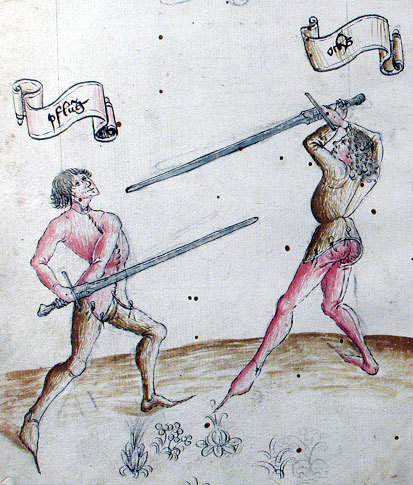All arts have length and measure.
-- Johannes Liechtenauer
I'm considering how to make a melee combat system for roleplaying games that better simulates historical fencing.
For a few years, I've had a casual interest in the late medieval/renaissance fechtbucher and schools of combat. These manuals describe the techniques used in civilian combat and duels: typically unarmored, with a one or two-handed sword, buckler or dagger. Later books in the same genre describe fighting with early rapiers, again paired with an open hand or a secondary weapon. Various modern teachers and organizations have reconstructed these techniques for sport and practice. (If you're in Richmond, Salle Green offers a variety of courses.)
I have found the experience to be very different from the manner in which most roleplaying games depict these weapons and the experience of using them.
In games such as Dungeons and Dragons, or online games such as the Elder Scrolls, the various combatants are represented as having a measure of health. Weapons are represented as having a range of damage. The fighters proceed to whack at each other. If hits are successful, "damage" is subtracted from "health" until one combatant is dead. Winning a bout usually takes multiple blows on a foe, and no one seems to take significant impairing injury until they fall over dead. Overall, the effect is like seeing two mounds of spam whittle away at each other with cheese graters.
Instead, I'd like to offer the following basic assumptions for a combat system:
- Any weapon, with a proper strike, is potentially deadly. I'm tired of seeing roleplaying games in which weapons are rated entirely based on how big they are when clobbering someone. Knives (typically the most pathetic weapon in an fantasy roleplaying game) are a dangerous weapon in real life. Doubt me? (https://www.youtube.com/watch?v=uDGHKyB3T_U)
- A single, well-executed strike can potentially kill or incapacitate any opponent. Whether you are Andr'e the Giant or Steve Buschimi, a rapier-strike in the torso is deadly. No matter how big and tough a person your may be, your liver is not especially better at repelling 6 inches of steel.So big tough strong characters should better resist minor injuries, but not so much lethal strikes.
- The combat is a contest of skill (and luck), positioning and reaction. Fencing is about timing and distance, attack and parry, and the geometry of the interaction of blades.
Furthermore, I'd like my system to incorporate some general observations on Renaissance weaponry and the interactions between main-hand weapons and use of the off-hand, either open or with a dagger or buckler.
- In most combat systems, a one-handed sword forms the basic teaching weapon. In medieval systems, this was an arming sword which could either cut or thrust. As we move into rapier combat, it becomes more and more a thrusting weapon, with an increasingly vestigial cutting capacity. Much of the footwork remains similar, and less rigidly linear than modern fencing, as fencing would be in the round rather than on a piste.
 |
| Rapier. 17th century. Wikipedia. |
- The off-hand was always an important element of combat, regardless of whether it was holding anything, and indeed, open or equipped it was put to similar uses. Even an open hand can push a blade aside, grapple an opponent, or deliver a punch. Indeed, some techniques involve dropping a weapon at close range in order to better grapple. Many things were held in the off hand: daggers, bucklers, secondary swords, even lanterns or capes. But their roles were all fundamentally similar.
 | |
| Grappling and throws. Wikipedia |
- Most roleplaying games assume that the purpose of a secondary weapon is to make a second attack, and fighters with a sword and dagger are portrayed as super-chopping death-Cuisinarts (usually with a decreased chance of self defense). I' don't think this would be the case. A fighter armed with a secondary dagger might stab with it, if he got in close, but he would be more likely to use the dagger to parry, and to control his foe in order to strike with his main weapon. Indeed, the dagger's main use as a weapon (rather than a parry stick) would be inside the reach of a sword, in the same sort of way as a fighter with an empty hand might punch or grapple or strike with the pommel.
- Likewise, most roleplaying games give a hefty defensive bonus to a shield. This might be so with a large shield, but these were not often used in civilian combat of the period. Instead, the more common implement would be a buckler, a shield about the size of large dinner-plate or a platter (for the big ones). A buckler cannot protect one's entire side, but used actively it parries well. Up close, it can be used to impede the opponent's blade movement, or you can punch them with it.
 |
| Sword and Buckler (late 13th century). Wikipedia. |
- Two-handed swords(like a two-handed sword or a bastard sword) are fast, versatile weapons. A typical Renaissance two-handed blade is about a foot longer than a one-handed sword, with maybe another half a foot more handle. The main hand holds the handle near the hilt and acts as a pivot, with the off-hand on the lower handle or pommel. (Much like holding a baseball bat.) This is one of the most satisfying of weapons to swing around, and it's one that I think most roleplaying games get completely wrong: most games give the weapon a bonus to damage, but lower defense or speed. However, in my experience these swords are not especially heavy (only about 3 pounds max). The may indeed strike with more force than a shorter weapon, but as I said above, I'm not sure how significant this would be, since even a smaller weapon is capable of a lethal blow. Neither are two-handed swords slow or awkward -- they are quite capable of parrying, having an extra foot or 18" of steel with which to do so. This compensates for not having a buckler or parrying dagger, and up close the pommel can deliver blows like the butt of a staff. The greatest advantage of a two-handed sword is, in fact, one one that few rpgs address adequately -- range. A two-handed sword can strike an opponent a pace or so farther away than a normal sword, meaning an opponent must enter its range before being able to make an attack of their own. Incidentally, there is an even bigger two-handed sword, used to attack pike squares that's even bigger. Such huge weapons are a bit awkward and might justify the rpg stereotype.
 |
| The two-handed longsword in different positions. Wikipedia. |
_107v.jpg) |
| Hitting someone in the face with the pommel of a 2-handed sword. WIkipedia. |
Next time: I will try my hand at modeling these assumptions in an rpg combat system.









No comments :
Post a Comment